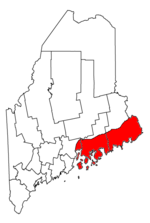
Maine is the easternmost state in the New England region of the Northeastern United States. It borders New Hampshire to the west, the Gulf of Maine to the southeast, and the Canadian provinces of New Brunswick and Quebec to the northeast and northwest, respectively. Maine is the largest state in New England by total area. Of the 50 U.S. states, it is the 12th-smallest by area, the 9th-least populous, the 13th-least densely populated, and the most rural. Maine's capital is Augusta, and its most populous city is Portland, with a total population of 68,408, as of the 2020 census.

Rockland is a city and county seat of Knox County, Maine, United States. As of the 2020 census, the town population was 6,936. The city is a popular tourist destination. It is a departure point for the Maine State Ferry Service to the islands of Penobscot Bay: Vinalhaven, North Haven and Matinicus.

The Seacoast Region is the southeast area of the U.S. state of New Hampshire that is centered around the city of Portsmouth. It includes the eastern portion of Rockingham County and the southern portion of Strafford County. At its narrowest definition, the region stretches 13 miles (21 km) along the Atlantic Ocean from New Hampshire's border with Salisbury, Massachusetts, to the Piscataqua River and New Hampshire's border with Kittery, Maine. The shoreline alternates between rocky and rough headlands and areas with sandy beaches. Some of the beaches are bordered by jetties or groins, particularly in the towns of Rye and Hampton. Most definitions of the Seacoast Region includes some inland towns as well, including the Great Bay area cities of Dover and Rochester, the college town of Durham, and areas as far west as Epping. Some definitions also include nearby portions of York County, Maine that are culturally aligned with the Portsmouth area rather than the Portland, Maine metropolitan area.

The Downeaster is a 145-mile (233 km) passenger train service operated by Amtrak and managed by the Northern New England Passenger Rail Authority (NNEPRA), an agency of the state of Maine. Named for the Down East region of Maine, the train operates five daily round trips between North Station in Boston, Massachusetts, and Brunswick, Maine, with ten intermediate stops.
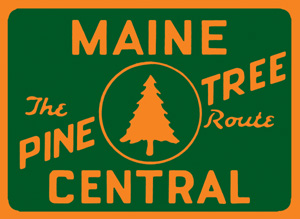
The Maine Central Railroad was a U. S. class 1 railroad in central and southern Maine. It was chartered in 1856 and began operations in 1862. By 1884, Maine Central was the longest railroad in New England. Maine Central had expanded to 1,358 miles (2,185 km) when the United States Railroad Administration assumed control in 1917. The main line extended from South Portland, Maine, east to the Canada–United States border with New Brunswick, and a Mountain Division extended west from Portland to St. Johnsbury, Vermont, and north into Quebec. The main line was double track from South Portland to Royal Junction, where it split into a "lower road" through Brunswick and Augusta and a "back road" through Lewiston, which converged at Waterville into single track to Bangor and points east. Branch lines served the industrial center of Rumford, a resort hotel on Moosehead Lake and coastal communities from Bath to Eastport.
Eastern New England English, historically known as the Yankee dialect since at least the 19th century, is the traditional regional dialect of Maine, New Hampshire, and the eastern half of Massachusetts. Features of this variety once spanned an even larger dialect area of New England, for example, including the eastern halves of Vermont and Connecticut for those born as late as the early twentieth century. Studies vary as to whether the unique dialect of Rhode Island technically falls within the Eastern New England dialect region.
John Thomas Gould was an American humorist, essayist, and columnist who wrote a column for the Christian Science Monitor for over sixty years from a farm in Lisbon Falls, Maine. He was published in most major American newspapers and magazines and wrote thirty books.

The railroad history of Portland, Maine, began in 1842 with the arrival of the Portland, Saco & Portsmouth Railway (PS&P). Most of the rail activity in Portland revolved around agricultural goods bound for export and import freight from Europe. Yet Maine's largest city also enjoyed 125 years of continuous passenger rail service, from 1842 until 1967, and Amtrak began serving the city in 2001. For most of Portland's history, passenger train schedules were designed with intercity travel rather than daily commuting in mind; passenger activities were mostly confined to intercity travel from Portland to Boston, Montreal, Nova Scotia, and points west.
Down Easter or Downeaster may refer to:

Brunswick Maine Street Station, or Brunswick station, is a multi-modal, multi-use real estate development in Brunswick, Maine. Located on Maine Street, it consists of commercial offices, service centers, healthcare, retail, restaurants, theater and residential space. Brunswick Station is also a transportation hub for city buses, taxis, and passenger trains.
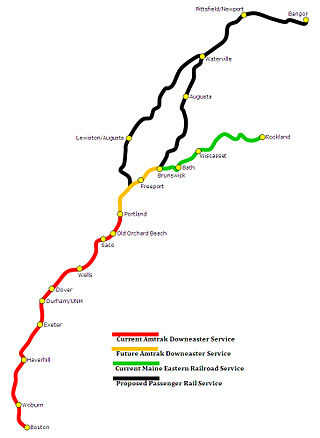
Trainriders Northeast is a non-profit citizens' organization group based out of Portland, Maine, in the United States. It was established in 1989 to advocate for the extension of passenger rail service from Boston to Portland and points north. Today Trainriders Northeast may be most well known for their role in bringing passenger service back to Portland, with the Amtrak Downeaster.
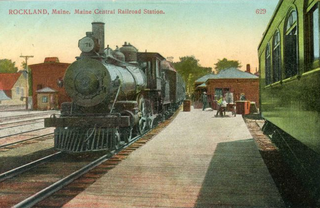
Rockland station is a railway station located at Union and Pleasant Streets in Rockland, Maine. It is the eastern terminus of the Rockland Branch, a state-owned track connecting Rockland and Brunswick. The historic station building was built in 1917 by the Maine Central Railroad, and was listed on the National Register of Historic Places in 1978 as Rockland Railroad Station. It presently houses a restaurant, and served for a time as Rockland's city hall. The line is presently inactive, having most recently had seasonal passenger service from 2004 to 2015 operated by the now-defunct Maine Eastern Railroad. The line would then be leased to the Central Maine and Quebec Railway (CMQ) from 2015 to 2020, then to Canadian Pacific Railway following its purchase of CMQ in 2020. CMQ originally planned to reintroduce service on the line, but not with excursions.
Down East is a term for parts of eastern New England and Canada's Maritime Provinces.

Canadian fiddle is the aggregate body of tunes, styles and musicians engaging the traditional folk music of Canada on the fiddle. It is an integral extension of the Anglo-Celtic and Québécois French folk music tradition but has distinct features found only in the Western hemisphere.
The following is a timeline of the history of the city of Portland, Maine, USA.
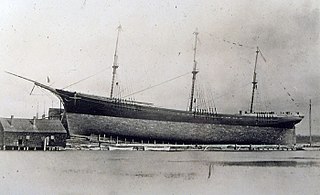
The Down Easter or Downeaster was a type of 19th-century sailing ship built in Maine, and used largely in the California grain trade. It was a modification of the clipper ship using a similar bow but with better cargo handling. It achieved a balance between speed and tonnage such that it made the wheat trade between California and Great Britain competitive with east coast grain trade via steam ship. It could make the trip between San Francisco and Liverpool in 100 days, despite rounding Cape Horn and crossing the equator twice. A more unusual name for the rig was shipentine.
Donald Soctomah is a Native American author, filmmaker, historian, and politician. He serves as the tribal historic preservation officer for the Passamaquoddy tribe, where he works with both the U.S. and Canadian governments on the protection of culturally significant sites, artifacts and knowledge. Soctomah has written several books about Passamaquoddy history, as well as a children's book, Remember Me: Tomah Joseph's Gift to Franklin Delano Roosevelt and The Canoe Maker.
The Maine accent is the local traditional accent of Eastern New England English spoken in parts of Maine, especially along the "Down East" and "Mid Coast" seaside regions. It is characterized by a variety of features, particularly among older speakers, including r-dropping (non-rhoticity), resistance to the horse–hoarse merger, and a deletion or "breaking" of certain syllables. The traditional Maine accent is rapidly declining; a 2013 study of Portland speakers found the older horse–hoarse merger to be currently embraced by all ages; however, it also found the newer cot–caught merger to be resisted, despite the latter being typical among other Eastern New England speakers, even well-reported in the 1990s in Portland itself. The merger is also widely reported elsewhere in Maine as of 2018, particularly outside the urban areas. In the northern region of Maine along the Quebec and the New-Brunswick border, Franco-Americans may show French-language influences in their English. Certain vocabulary is also unique to Maine.

Union Station was a train station in the Libbytown neighborhood of Portland, Maine, which operated from 1888 to 1960. It was demolished in 1961 and is now the site of a strip mall.
The St. Croix Downeasters were a minor league baseball team based in Calais, Maine in partnership with neighboring St. Stephen, New Brunswick. In 1913, the Downeasters played as members of the Class D level New Brunswick-Maine League. The league folded during the season, with the Downeasters in third place. The Downeasters hosted minor league home games at Athletic Field in Calais, Maine.
